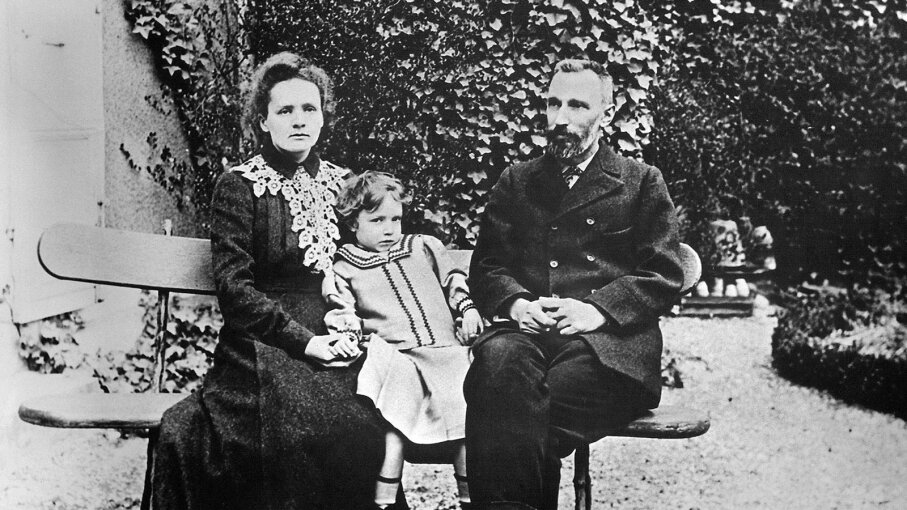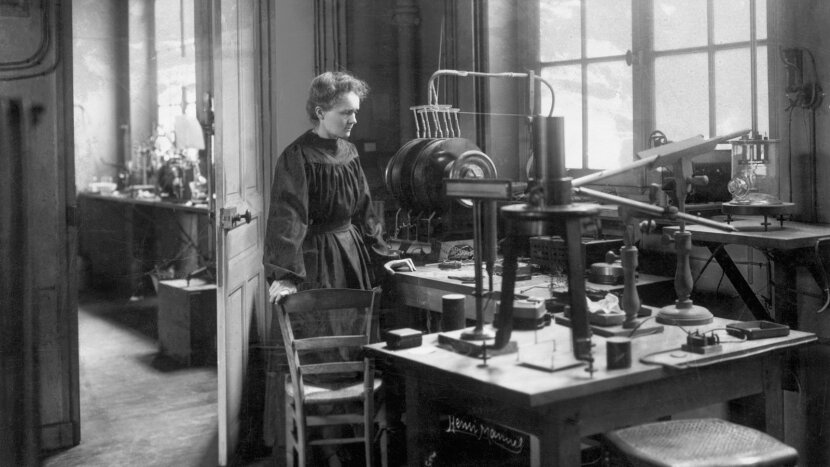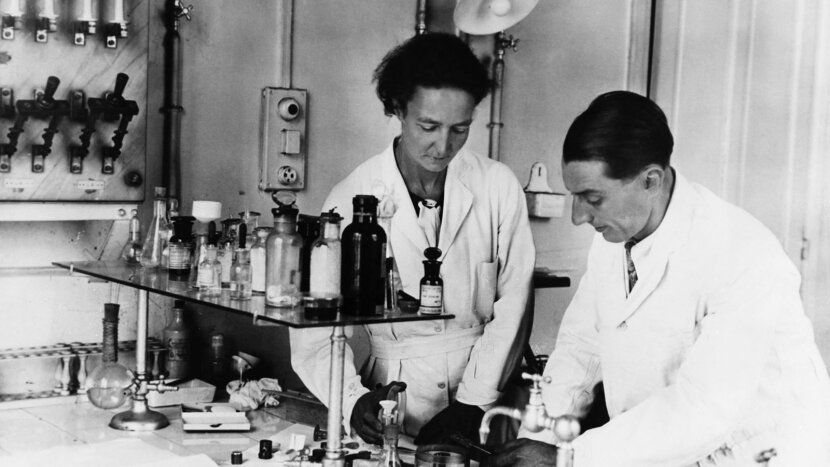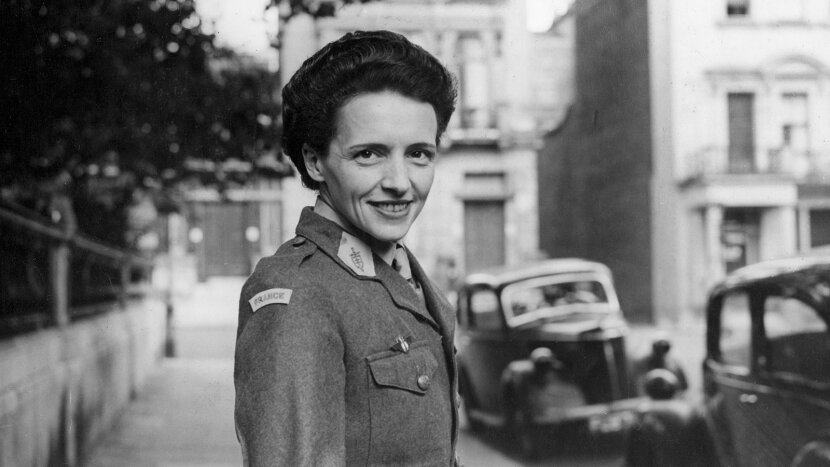
When Marie Curie and her husband Pierre won the Nobel Prize for physics in 1903, their older daughter Irène was just 6 years old. Little could they have imagined that not only would Marie go on to win a second Nobel in chemistry in 1911 — the first person ever to receive the prize twice — but Irène and her husband, Frédéric Joliot, would take home their own Nobel in chemistry in 1936. And in 1965, their younger daughter Ève's husband, Henry Labouisse, would accept the Nobel Peace Prize on behalf of UNICEF, the humanitarian organization he ran. Here's what you need to know about this family, which holds more Nobel Prizes than any other.
1. Marie's Nobel Prizes Were Controversial
She was the first woman to receive a Ph.D. in France. The first female professor at the Sorbonne. The first woman to win the Nobel Prize. The first person to win more than one Nobel Prize (and to this day, the only woman to win more than once). And the first person to win a Nobel in more than one scientific field.
Yet members of the French Academy of Sciences nominated only Pierre and Becquerel for the prize. Marie was included only after Pierre Curie worked to persuade some on the Nobel committee that his wife deserved to share the honor, too. At the awards ceremony, the president of the Swedish Academy downplayed her contributions, quoting the Bible in his speech: "It is not good that man should be alone, I will make a helpmeet for him."
Eight years later in 1911, Marie was the sole recipient of the Nobel Prize in Chemistry, in recognition of her discovery of radium and polonium and her subsequent research into the nature of these elements. Even then, "there were some who believed that Marie Curie received the second Nobel essentially for the same work and didn't deserve it," says Naomi Pasachoff, author of "Marie Curie and the Science of Radioactivity."
2. Pierre Was Marie's Great Love — and Greatest Collaborator
Marie, who was born Marya Sklodowska in 1867, met Pierre Curie in 1894 when she took a job in Pierre's lab. Pierre, then a 35-year-old physicist studying crystals and magnetism, quickly fell in love with the 27-year-old Marie. The next year, they were married.

Though Pierre was several years her senior, it was Marie who steered their work into radiation. For her doctoral thesis, she began building on the work of Becquerel and German physicist Wilhelm Röntgen, who had recently discovered X-rays. Marie eventually hypothesized that the mysterious penetrating rays were a property of the element's atoms.
Pierre shelved his work with crystals to help Marie further her discoveries. They set out to measure the strength of the rays by adapting an instrument developed by Pierre. Studying an ore containing uranium, Marie noted that it emitted much more radiation than one would expect from the element alone. While investigating the source of the rays, they discovered two new radioactive elements — radium and polonium, which Marie named for Poland, the country of her birth. Polonium was 400 times more radioactive than uranium.
The pair were deeply devoted to their work and to one another. Yet just three years after they won the Nobel Prize, their collaboration ended tragically when Pierre was run over by a horse-drawn cart. Marie was devastated. "From all accounts Marie loved her husband deeply and was overwhelmed with grief, so much so that she refused to talk about Pierre," says Shelley Emling, author of "Marie Curie and Her Daughters: The Private Lives of Science's First Family" in an email interview.
In a biography of Pierre published by Marie in 1923, she wrote, "It is impossible for me to express the profoundness and importance of the crisis brought into my life by the loss of the one who had been my closest companion and best friend. Crushed by the blow, I did not feel able to face the future. I could not forget, however, what my husband used sometimes to say, that, even deprived of him, I ought to continue my work."
3. The Nobel Prizes Made Marie a Big Celebrity
More than 150 years after her birth, Marie Curie remains one of the most famous female scientists. But even during her life, the reserved Marie was a superstar. "She was a renowned scientist at a time when there were virtually no women in the field," says Pasachoff. "She was a heroine, she was an oddity. In some ways, she was famous for being famous."
In 1921, Marie and her two daughters set off across the Atlantic Ocean on their first journey to America, where Marie was mobbed by fans and given a queen's welcome. In New York, Marie was toasted at the Waldorf Astoria, Carnegie Hall, and the American Museum of Natural History, which hosted an exhibit dedicated to her discovery of radium. Universities conferred honorary degrees on her, and President Warren G. Harding held an event in her honor at the White House.
"Until that time, her daughters had no idea their mother was famous," says Emling. "Marie was nothing if not humble. But everywhere they went in America they were greeted by throngs of reporters and flashing cameras. People wanted Marie's autograph. The girls were stunned, as was Marie."
4. A Teenaged Irène Taught Radiation Courses
Marie was determined not to give up her scientific work after her daughter Irène was born in 1897. "But although she was relentless in her scientific pursuits, she also was devoted to her daughters," says Emling.
"It's true that she wasn't able to spend an inordinate amount of time with her children — which meant Marie's father-in-law and others often cared for them — but she did lead by example," Emling adds. "And she was very involved in their upbringing," especially after the death of Pierre. For example, Marie enrolled her girls in a cooperative school in which the parents took turns teaching the children lessons in their areas of expertise. (Marie taught physical sciences.)

As the years went on, Irène took her father's place as Marie's colleague. During World War I, Marie chose a teenaged Irène to assist her in bringing X-rays to the battlefront to treat wounded soldiers. Irène worked alongside her mother running mobile X-ray units in field hospitals and specially outfitted vehicles, which the soldiers dubbed "petites Curies."
"Marie felt so confident in her daughter's knowledge and abilities that she had Irène give courses in radiation to soldiers and nurses," says Pasachoff. "This was even before Irène had earned her university degree."
Later, Irène became her mother's assistant at the Radium Institute while completing her studies. It's there that Irene met engineer Frédéric Joliot, a trainee in Marie's lab, whom she married in 1926. In 1934, the couple made a bombshell discovery when they figured out a way to artificially create radioactive atoms in the lab. It earned them a shared Nobel in chemistry the following year, making Irène and her parents the only mother-daughter and father-daughter pairs ever to receive the prize. Like her mother, Irene died of prolonged exposure to radiation.
5. Ève Was the Social Butterfly in the Family
"Born seven years apart, Ève and her older sister Irène couldn't have been more different," says Emling. "Irène was quiet and studious, preferring to stay home and read a book to going out and socializing. Ève was, by all accounts, a true beauty who enjoyed a wide circle of friends."

Rather than follow her parents into the sciences, Ève found success as a writer. Perhaps her best-known work was "Madame Curie," a biography of her mother that she wrote after Marie died in 1934. The book became a huge bestseller and earned Ève literary acclaim.
Reviewing it in The New York Times, critic Charles Poore called "Madame Curie," a biography that stirs the heart and the mind by a fine counterpoint of sense and sensibility, a great story superbly told."
"During World War II, Ève became a foreign correspondent, traveling tens of thousands of miles to wartime fronts that included Iran, Iraq, India, China, Burma and North Africa," says Emling. There, she gathered enough material for a second bestselling book, "Journey Among Warriors." "When Ève arrived for a book tour in the United States — where her smiling face graced the cover of Time magazine in February 1940 — she was greeted as a celebrity. She gave lectures and had dinner with Eleanor Roosevelt."
After the war, Ève turned to humanitarian work. In 1952, she was appointed special adviser to the first secretary general of NATO. In 1954, she married an American diplomat, Henry Richardson Labouisse, who later became the executive director of UNICEF.
"Ève travelled to dozens of developing countries on behalf of UNICEF, and her tireless efforts earned her the title of First Lady of UNICEF," says Emling. In 1965, when UNICEF was awarded the Nobel Peace Prize, it was Labouisse who accepted the honor on the organization's behalf — the fifth person in the Curies' extended family to receive the prize. Ève died in 2007 at the ripe old age of 102.
